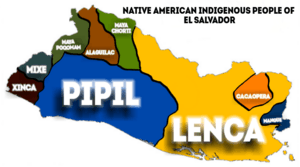Lencan languages facts for kids
Quick facts for kids Lencan |
|
|---|---|
| Ethnicity: | Lenca people |
| Geographic distribution: |
El Salvador, Honduras |
| Linguistic classification: | Macro-Chibchan ?
|
| Subdivisions: |
Honduran Lencan †
Salvadoran Lencan †
|
Lencan is the name for a small group of languages that are almost gone. These languages were spoken by native people in Mesoamerica, which is a historical region in Central America.
Contents
What are the Lencan Languages?
There were two main Lencan languages. Sadly, both of them are now extinct, meaning no one speaks them anymore.

- Salvadoran Lencan was spoken in places like Chilanga and Potó in El Salvador. The Lenca people arrived in El Salvador about 2,000 years ago. They even founded an ancient city called Quelepa. Today, only one person is known to still speak this language.
- Honduran Lencan was spoken in different areas of Honduras, including Intibucá, Opatoro, and Santa Elena. There were small differences in how it was spoken from place to place. A few phrases from this language still exist, but it's not known if anyone speaks it fully anymore.
These two Lencan languages were not very closely related. Experts believe they separated about 3,000 years ago. This means they had a common ancestor language a very long time ago.
Family Connections: Are Lencan Languages Related to Others?
Scientists who study languages often try to find out if different language families are related. It's like building a giant family tree for languages! For Lencan languages, these connections are still being debated.
Some experts have suggested that Lencan languages might be part of a bigger language family called Macro-Chibchan. However, not everyone agrees on this.
More recently, some linguists have found evidence that Lencan languages might be related to two other language families: Misumalpan and Chibchan. They call this bigger group the "Lenmichí Micro-Phylum."
If this is true, it means that the common ancestor of Lencan and Misumalpan languages split off from the Chibchan languages around 9,700 years ago. Then, the Lencan and Misumalpan languages separated from each other about 7,700 years ago.
Another idea is that Lencan languages could be linked to the Xincan family. Some studies have found similar words between them. However, these similarities could be because the languages borrowed words from each other, not necessarily because they came from the same ancient language.
A Look Back: The History of Lencan Languages
The original home of the ancient Lencan language was probably in central Honduras. This is where the language family likely began.
When the Spanish arrived in Central America in the early 1500s, the Lenca language was spoken by the Lenca people. They lived in parts of Honduras and eastern El Salvador, east of the Lempa river.
Even though the Lenca people still live in these areas today, their language has almost disappeared. In the 1970s, a linguist named Lyle Campbell found only one person who could still speak Salvadoran Lenca in Chilanga, El Salvador. He found no speakers in Honduras. He also confirmed that Salvadoran Lenca was a different language from Honduran Lenca.
Today, there are groups of native people in both countries who are working hard to bring the Lencan language back to life. There have even been reports that textbooks for Salvadoran Lenca have been given to schools in the region to help teach the language to new generations.
A novel from 2002, called La guerra mortal de los sentidos by Roberto Castillo, tells the story of someone searching for the Lenca language.
See also
 In Spanish: Lenguas lencas para niños
In Spanish: Lenguas lencas para niños

